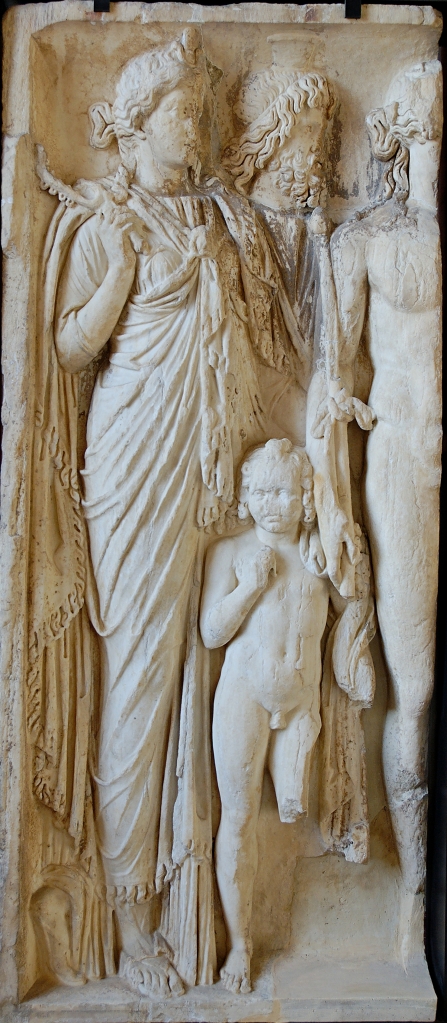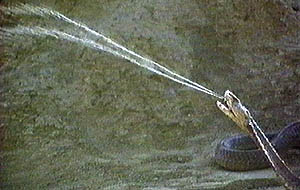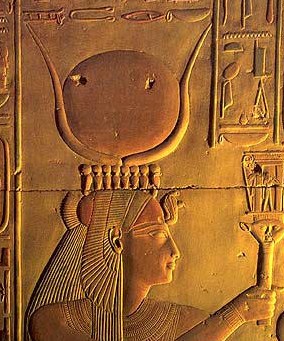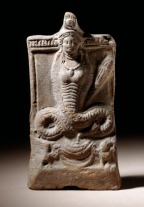I’m taking the holiday weekend off, so here’s a repost of what I think is an important connection.
Warning: this post refers to rape in myth.

During the excavation of Hathor’s temple at Denderah, an interesting statue, now in the Cairo Museum, came to light. It shows two children, one male, one female, standing within the protective coils of two serpents. On the boy’s head is a solar disk with an Eye of Horus on it. The girl has a lunar disk with an Eye of Horus.
The statue appears to be a votive gift, and may have originally come from the shrine of Isis-Thermouthis, believed to be not far from Denderah. According to experts, the serpents are most likely Isis-Thermouthis and Serapis Agathos Daimon.
In the Ptolemaic period, Isis and Serapis/Osiris were frequently depicted as Divine Serpents. The Isis serpent can sometimes be the combined Goddesses Isis and Renenutet as Isis-Thermouthis. Other times, She can be Isis Agathe Tyche, Good Fortune. In both forms, She is partnered with Serapis/Osiris Agathos Daimon, or Good Spirit.
Unfortunately, there is no writing on the statue to help with the identification of the Divine Children. One possibility is that They are the well-known twins, Shu and Tefnut. There are things in myth and at the site that could support this interpretation. But as you might guess, I like a different possibility.
The male child has the Horus lock, so He is probably Harpokrates, in Egyptian Hor-pa-khred, Horus the Child. Harpokrates was very popular during this time period. He is the child of Isis and Serapis and is frequently shown with a sun disk on His head. The fact that the Child God is protected by Isis and Osiris serpents, strengthens the identification. But if the boy is Harpokrates, Who is the little girl?
We don’t know of a twin sister of Harpokrates from either Egyptian or Greek sources. Some have wondered whether the lunar girl is supposed to be a form of Isis. Indeed Isis is called the Female Horus (Hor-et or Horit) in Egyptian sources. Several other Goddesses and a number of queens are called by the name as well. The Oxyrhynchus Hymn to Isis, written in Greek, calls Her Harpokratin, which is just Harpokrates with the Greek feminine ending. Translators have taken this to mean something like “the darling-girl of the Gods,” but it can just as easily be simply “Horet the [Girl] Child.” What’s more, by Ptolemaic times, Isis was indeed connected to the moon, even though She was not in earlier Egyptian sources.
Nevertheless, I stubbornly like the idea that the Divine Girl could be Horus’ twin sister, Horet. While this is the only statue we know of that shows the Harpokrates Twins together, during the Ptolemaic period, there are a few other baby girl statues that have been identified as Girl Harpokrates. We have no evidence of Her before this time, but we know that the Egyptians always did have a penchant for name-sharing male-female pairs of Deities, such as the Deities of the Ogdoad of Hermopolis.

Now, there is a Goddess Horit Who shows up in late Egyptian sources, specifically in what is known as the Delta Mythological Manual. Scholars aren’t sure where the manual came from, but they date it to about the 26th dynasty—though the material may be much older. It contains myths having to do with 12 of the nomes in the Egyptian delta. It could have come from a temple cache or been in the possession of a priest or maybe even a priestess. In this manual, we meet Horit. She is a daughter of Osiris, but we do not know Who Her mother is.
And…then things get bad.
You see, Horit bears sons fathered by Her father Osiris. The Delta Manual is pretty darned cryptic, but we learn that when Her father raped Her, it was Her “first time” and that when She learned She was pregnant, She “sat down and mourned.” What’s more, there was something wrong or unusual about the birth of the resulting child. The text isn’t super clear, but Horit may have either chosen abortion or miscarried. The child, being Divine, did not die, but instead left the premises immediately.
After this, Horit functions as a wife to Osiris and bears four more children, the last one after suffering a rape by Set. The manual (again very cryptically) tells stories about each of these sons of Horit—all forms of Horus. Strangely, there is even one called The Child of Isis. Of the third of these sons, the manual tells us that after Set murders Osiris, Horit raises Their son to be His father’s avenger; very Isis-like indeed. There is even an incident of decapitation just as there is in the story where Isis grants mercy to Set, which so enrages Horus (the two Gods are battling at the time) that He decapitates Isis, a state of affairs that wise Thoth fixes right away.
In the Delta Manual, the identities of all the Goddesses are very fluid; quite confusingly so. They are associated, joined, or become each other frequently. Horit is identified with Hathor and it is said that “She is the Divine hand of Re,” which is specifically a vagina. (In this version of the story, Re replaces Atum Who uses His Goddess-Hand to masturbate, producing Shu and Tefnut.)
Many of the myths in the Delta Manual, and most of Horit’s, have to do with boundary-crossing sex among Deities, consensual or not. In addition to Hathor, Horit is associated with Bast, Who is said to “come forth as Horit.” At Sebennytos and Behbeit (Isiopolis!), Horit is joined with Tefnut and the myth of the Raging/Distant/Returning Goddess (which is an important myth for another day). Sebennytos and Behbeit are in the 12th delta nome. There, the myths relate that Tefnut-Horit is raped by Her son Geb and imprisoned. The rapist is eventually punished and the Goddess freed, which becomes a cause for festival in the nome. So now, in addition to the rape of Horit the daughter by Her father Osiris, we also have the rape of Horit-Tefnut the mother by Her son. Some of you may know that there is similar tale in which Horus rapes His mother Isis and Her tears fall into the water.
WTF? Is it any wonder that Horit is among the raging Goddesses? And what the heck are we to supposed to make of all this anyway? We certainly do not approve. But neither did the ancient Egyptians. After all, Geb (and Set in other tales) is punished for His rape. And yet, the Egyptians retained these stories and, no doubt, tried to make sense of them.
I have speculated, in Isis Magic, about the possible meaning of the rape of Isis by Her son. It goes like this: What if that story, and others like it, are merely the very misunderstood remnants of a different and very ancient story; indeed, perhaps the oldest story? The Goddess Comes Into Being; of Herself, by Herself. She gives birth to a Child, a son. He grows to maturity. Then, in order to start the multiplication of life on earth, Divine Mother and Divine Son mate, not in a rape, but because They are All That Is. Could the same be said of the Divine Father and Divine Daughter? Obviously, I don’t know the answer to these questions. But it’s a way I can try to make it make some sense in my own head.
As for Harpokrates and His twin sister, I doubt we can make a direct connection between Horit and the Girl Harpokrates of the votive statue. And yet, and yet, and yet. Osiris has a son, Hor, and a daughter, Horit. (Different mothers? Same mother?) Hor and Horit make a perfect Egyptian name-sharing male-female pair. Horit’s myths come from the delta, including from Behbeit, where Isis’ great delta temple once stood.
I wonder whether we will some day find stories about Horit and Her mother? And if we do, what will Her name be?
















